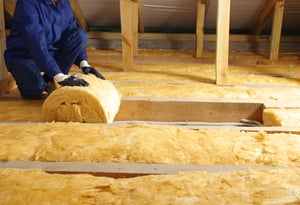When it comes to energy efficiency, U-values play a crucial role in Part L compliance. Part L sets specific targets for U-values, which are the maximum allowed heat transfer rates for building elements like walls, roofs, windows, and doors.
These targets ensure that these components meet minimum insulation standards, reducing heat loss or gain.
{Need help with Part L compliance? Sablono's powerful features enhance accountability, compliance-proof your workflows and protect against claims. Learn more here: Sablono's construction compliance software}
We've collated the latest recommended U-Values straight from Appendix B of Approved Document L Volume 1 (with 2023 amendments)
Skip to:
- Summary of notional dwelling specification for new dwelling
- U-values for party walls
- Limiting U-values for new fabric elements and air permeability in new dwellings
- Limiting U-values for new fabric elements in existing dwellings
- Limiting U-values for existing elements in existing dwellings
Part L Building Regulations U Values
Disclaimer: These U-values provide general guidance, but it's important to refer to the most recent version of Part L and any associated documents, as well as consult with building professionals, architects, or local building control authorities to ensure compliance with specific project requirements.
Summary of notional dwelling specification for new dwelling:
Element or system |
Reference value for target setting |
|
Opening areas (windows, roof windows, rooflights and doors) |
Same as for actual dwelling not exceeding a total area of openings of 25% of total floor area |
|
External walls including semi-exposed walls |
U = 0.18 W/(m²·K) |
|
Party walls |
U = 0 |
|
Floors |
U = 0.13 W/(m²·K) |
|
Roofs |
U = 0.11 W/(m²·K) |
|
Opaque door (less than 30% glazed area) |
U = 1.0 W/(m²·K) |
|
Semi-glazed door (30–60% glazed area) |
U = 1.0 W/(m²·K) |
|
Windows and glazed doors with greater than 60% glazed area |
U = 1.2 W/(m²·K) Frame factor = 0.7 |
|
Roof windows |
U = 1.2 W/(m²·K), when in vertical position |
|
Rooflights |
U = 1.7 W/(m2·K), when in horizontal position (for correction due to angle, see specification in SAP 10 Appendix R) |
Get this sent to your inbox: Download summary
U-values for party walls:
|
Party wall construction |
U-value W/(m2·K) |
|
Solid |
0.0 |
|
Unfilled cavity with no effective edge sealing |
0.5 |
|
Unfilled cavity with effective sealing around all exposed edges and in alignment with insulation layers in abutting elements |
0.2 |
|
A fully filled cavity with effective sealing at all exposed edges and in alignment with insulation layers in abutting elements |
0.0 |
Get this sent to your inbox: Download summary
Limiting U-values for new fabric elements and air permeability in new dwellings:
Element type |
Maximum U-value W/(m2·K) |
|
All roof types |
0.16 |
|
Wall |
0.26 |
|
Floor |
0.18 |
|
Party wall |
0.20 |
|
Swimming pool basin |
0.25 |
|
Window |
1.6 |
|
Rooflight |
2.2 |
|
Doors (including glazed doors) |
1.6 |
|
Air permeability |
8.0m3/(h·m2) @ 50Pa 1.57m3/(h·m2) @ 4Pa |
Get this sent to your inbox: Download summary
Limiting U-values for new fabric elements in existing dwellings:
Element type |
Maximum U-value W/(m2·K) |
|
Roof |
0.15 |
|
Wall |
0.18 |
|
Floor |
0.18 |
|
Swimming pool basin |
0.25 |
|
Window |
1.4 or Window Energy Rating Band B minimum |
|
Rooflight |
2.2 |
|
Doors with >60% of internal face glazed |
1.4 or Doorset Energy Rating Band C minimum |
|
Other doors |
1.4 or Doorset Energy Rating Band B minimum |
Get this sent to your inbox: Download summary
Limiting U-values for existing elements in existing dwellings:
|
Element |
U-value W/(m2·K) |
|
|
|
(a) Threshold |
(b) Improved |
|
Roof |
0.35 |
0.16 |
|
Wall–cavity insulation |
0.70 |
0.55 |
|
Wall – internal or external insulation |
0.70 |
0.30 |
|
Floor |
0.70 |
0.25 |
Frequently asked questions:
What are Part L U-values?
U-values measure the rate of heat loss through building elements like walls, roofs, and windows. They are crucial in ensuring buildings meet the required energy efficiency standards set by Part L Regulations.
How can I improve U-values in windows to comply with Part L Regulations?
To improve U-values in windows, consider using double or triple glazing, low-E coatings, and insulated window frames. These improvements can help you meet the U-alue targets set by Part L Regulations.
Do Part L Building Regulations U-values apply to all types of buildings?
Part L Building Regulations U-values apply to all new residential and commercial buildings in the UK. They are designed to ensure that all constructions meet minimum energy efficiency standards.
What happens if my building does not meet the U-value requirements of Part L Regulations?
Failure to meet the U-value requirements of Part L Regulations can result in non-compliance with building regulations, leading to penalties and difficulties in obtaining necessary certifications for the building.
Are there any exemptions to the U-value targets in Part L Building Regulations?
Some historic or special buildings may be exempt from certain U-value requirements in Part L Building Regulations. However, it is essential to check with local authorities or building control for specific exemptions.
How often are Part L Building Regulations U-values updated?
Part L Building Regulations are subject to periodic updates to align with advancements in energy efficiency standards and technologies. It is advisable to stay updated with the latest regulations to ensure compliance.
Where can I find more detailed information about Part L Building Regulations U-values?
For more detailed information about Part L Building Regulations U-values, you can refer to the official government website, energy efficiency guides, or consult with building professionals specialising in compliance with building regulations.



.png?width=1600&height=1000&name=MicrosoftTeams-image%20(76).png)